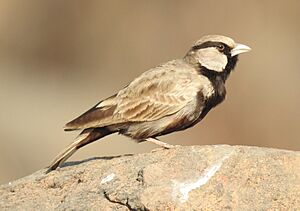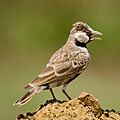Ashy-crowned sparrow-lark facts for kids
Quick facts for kids Ashy-crowned sparrow-lark |
|
|---|---|
 |
|
| Male | |
 |
|
| Female | |
| Conservation status | |
| Scientific classification | |
 |
|
| Synonyms | |
|
The ashy-crowned sparrow-lark (Eremopterix griseus) is a small bird, about the size of a House Sparrow. It's part of the lark family. These birds live in open areas like plains, with bare ground, grass, and bushes. You can find them across South Asia. Male birds have clear black and white markings on their faces. Females are sandy brown and look a lot like a female sparrow. During the breeding season, males are easy to spot. They make a long, whistling sound as they fly up and down in the sky.
Contents
About the Ashy-crowned Sparrow-Lark
The ashy-crowned sparrow-lark was first placed in a different bird group called Alauda. People also know this bird by other names. These include ash-crowned sparrow-lark and ashy-crowned finch-lark. Sometimes it's called black-bellied finch-lark or black-bellied sparrow-lark.
Different Types of Ashy-crowned Sparrow-Larks
Scientists have named some slightly different types, or subspecies. These include ceylonensis from Sri Lanka and siccata from Gujarat. However, most differences are small changes that happen over a wide area. So, scientists usually consider it one single species.
What Does the Ashy-crowned Sparrow-Lark Look Like?
This bird is about the size of a sparrow. It has a bill like a finch and short legs. You will usually see these birds sitting on the ground. They might perch on wires sometimes. But they do not perch in trees or bushes.
The male bird is sandy brown all over. It has a black belly, chin, and a black stripe near its eye. The top of its head is a dusty grey color. This is different from the black-crowned sparrow-lark. That bird has a dark brown or black head. The black-crowned sparrow-lark lives in some of the same dry areas.
The female bird is pale brown. She looks very much like a female house sparrow. However, the ashy-crowned sparrow-lark has much shorter legs. It also looks a bit more solid and has a shorter neck.
Where Do Ashy-crowned Sparrow-Larks Live?
These birds live in areas below 1,000 m (3,300 ft) in height. You can find them south of the Himalaya mountains. Their home range goes to Sri Lanka. It also reaches the Indus river in the west and Assam in the east.
They like places with old crops, bushes, and empty land. You can also find them near rivers on sand or on coastal mudflats. They do not usually go into the middle of desert areas. The black-crowned sparrow-lark prefers those places. The two species live in some of the same areas. But you rarely see them together in the exact same spot. During the rainy season, they move away from places with very heavy rainfall.
How Do Ashy-crowned Sparrow-Larks Behave?
These larks are often seen in pairs or small groups. In winter, they might form larger flocks. They look for food on the ground. They eat seeds and insects. If something scares them, they might crouch down. Then they will fly away quickly. They also eat fallen grains in farm fields. At night, they sleep on the ground. They make small dips in the soil to rest.
Breeding and Raising Young
These birds do not have a set breeding time. They breed mainly before the rains. This is usually from February to September in southern India. In Sri Lanka, it's from May to June.
The male bird performs a special song flight. He flies high up while making chirping sounds. Then he dives down with his wings partly closed. After that, he glides back up. This up-and-down flight has a long, low whistle with each dive. At the top of each rise, he makes a sharp chilp sound. The display ends with the male landing on a small mound. He will then repeat his performance after a few minutes.
The nest is a neat dip in the ground. It is placed under a clump of grass. The nest is lined with grass and hair. Some small stones are placed around the edge. The female usually lays two or three eggs. Both the male and female bird sit on the eggs to keep them warm. The eggs hatch after about 13 or 14 days. Both parents feed the young birds. The female usually does more of the feeding.
In Culture
In some Hindi languages, the bird's name is dabhak churi. This means 'crouching sparrow'. In the past, in British India, people hunted this bird for food. They called it an 'ortolan'.
Images for kids






